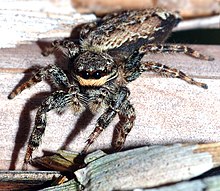Jumping spider
| Jumping spider | ||||||||||||
|---|---|---|---|---|---|---|---|---|---|---|---|---|

Spring Spider ( Marpissa muscosa ) |
||||||||||||
| Systematics | ||||||||||||
|
||||||||||||
| Scientific name | ||||||||||||
| Marpissa muscosa | ||||||||||||
| ( Clerck , 1757) |
The beef jumping spider ( Marpissa muscosa ) is a spider from the family of the jumping spiders (Salticidae). It mainly colonizes sunny tree trunks, posts or piles of wood.
description
Males reach a body length of 6 to 8 mm, females are 8 to 11 mm long. The species is one of the largest native jumping spiders. The prosoma has gray-brown to dark brown and light gray hairs. The strikingly elongated opisthosoma is camouflaged; in the middle there is a broad, light brown band, on both sides of which there are large, somewhat darker brownish spots. The legs are ringed light-dark. In contrast to many other members of the family, the color differences between males and females in the jumping spider are small. In the female, the eyes are outlined in black and there is a wide, orange band under the eyes. The males lack these features, but they have greatly enlarged the terminal limbs of the pedipalps .
distribution and habitat
The distribution of the jumping spider is limited to the Palearctic . The species is found throughout most of Europe, but is absent in Ireland and is restricted to the southeast in the UK. In Germany the species is apparently more common in the north and west than in the south and east.
The species inhabits tree trunks in dry forests or orchards , but also old wooden posts or boards. If suitable structures are available, it can also be found in open to semi-open areas such as dunes or grasslands .
Way of life
Jumping bark spiders, like most jumping spiders, prey on insects while jumping. In appropriate places they can be quite common. In the case of high density, a hierarchy is formed in which lower-ranking animals cautiously step back with their front legs spread apart (studies on another species of the genus). Environmental conditions shape the personality traits of the growing spiders. If the weather is unfavorable, look for an approximately 2 cm long residential web under loose tree bark or in wooden crevices.
The mating mainly takes place in May. Males perform a courtship dance in front of the females, then they follow the females into their hiding place and mate there. The female expands its residential web in summer and then produces up to five egg cocoons, which it guards until the young spiders hatch. The young spiders only mature after two years.
Danger
The species is widespread and common in suitable habitats. In Germany it is classified as "safe" in the Red List .
literature
- Heiko Bellmann : Cosmos Atlas Arachnids of Europe . 3rd edition, 2006. Kosmos, Stuttgart. ISBN 978-3-440-10746-1
- Ralph Platen, Bodo von Broen, Andreas Herrmann, Ulrich M. Ratschker & Peter Sacher: Total species list and red list of spiders, harvestmen and pseudoscorpions of the state of Brandenburg (Arachnida: Araneae, Opiliones, Pseudoscorpiones) with information on frequency and ecology. Nature conservation and landscape management in Brandenburg 8, booklet 2 (supplement); 1999.
Web links
Marpissa muscosa in the World Spider Catalog
Individual evidence
- ^ Norman I. Platnick, 2007: The World Spider Catalog, Version 8.0. American Museum of Natural History: Family Salticidae
- ↑ European distribution of the bark jumping spider on atlas.arages.de
- ↑ Distribution of the jumping spider in Great Britain and Ireland ( Memento from September 28, 2007 in the Internet Archive )
- ↑ Hänggi, Ambros; Stöckli, Edi; Nentwig, Wolfgang (1995). Habitat of Central European spiders. Miscellanea Faunistica Helvetiae - Center suisse de cartographie de la faune, Neuchâtel, ISBN 2-88414-008-5
- ^ RR Jackson, SD Pollard, AM Macnab, KJ Cooper (1990): The complex communicatory behavior of Marpissa marina, a New Zealand jumping spider (Araneae: Saltacidae). In: New Zealand Journal of Zoology , Volume 17, pp. 25-38, doi: 0301-4223 / 90 / 1701-0025 $ 2.50 / 0 .
- ↑ Jannis Liedtke, Daniel Redekop, Jutta M. Schneider, Wiebke Schuett (2015): Early environmental conditions shape personality types in a jumping spider. In: Ann V. Hedrick: The Development of Animal Personality , Frontiers Research Topics, Frontiers Media SA, Volume 3, No. 134, ISBN 2889451518 , ISBN 9782889451517 , doi: 10.3389 / fevo.2015.00134 .
- ↑ POM Steinhoff et al. (2018): Early environmental conditions affect the volume of higher-order brain centers in a jumping spider. In: Journal of Zoology , Vol. 304, No. 3, pp. 182-192.
- ↑ J. Liedtke, JM Schneider: Social makes smart: Rearing conditions affect learning in jumping spiders. P. 31 ff ( PDF ).


